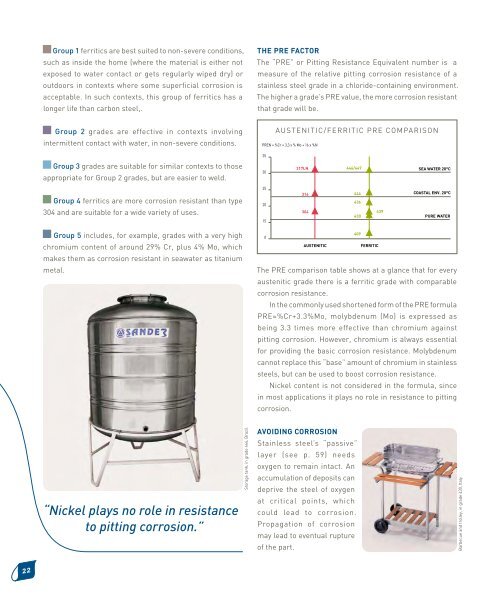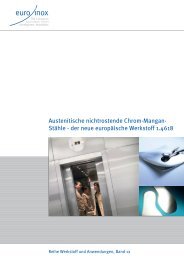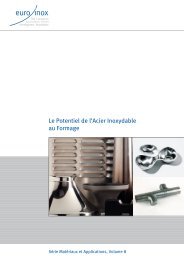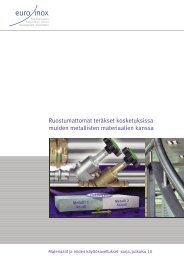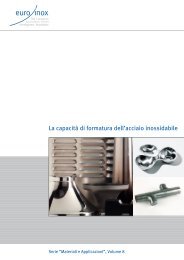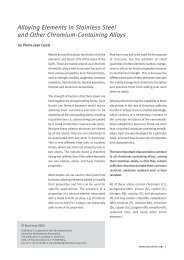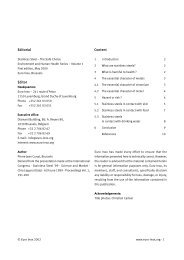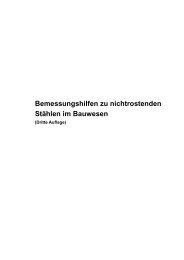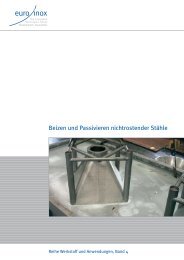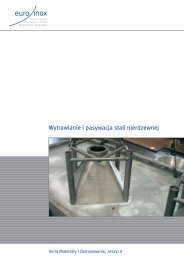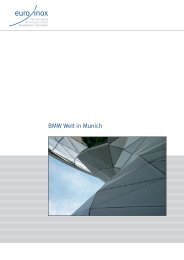The Ferritic Solution - Euro Inox
The Ferritic Solution - Euro Inox
The Ferritic Solution - Euro Inox
You also want an ePaper? Increase the reach of your titles
YUMPU automatically turns print PDFs into web optimized ePapers that Google loves.
group 1 ferritics are best suited to non-severe conditions,<br />
such as inside the home (where the material is either not<br />
exposed to water contact or gets regularly wiped dry) or<br />
outdoors in contexts where some superficial corrosion is<br />
acceptable. in such contexts, this group of ferritics has a<br />
longer life than carbon steel,.<br />
group 2 grades are effective in contexts involving<br />
intermittent contact with water, in non-severe conditions.<br />
group 3 grades are suitable for similar contexts to those<br />
appropriate for group 2 grades, but are easier to weld.<br />
group 4 ferritics are more corrosion resistant than type<br />
304 and are suitable for a wide variety of uses.<br />
group 5 includes, for example, grades with a very high<br />
chromium content of around 29% cr, plus 4% Mo, which<br />
makes them as corrosion resistant in seawater as titanium<br />
metal.<br />
“Nickel plays no role in resistance<br />
to pitting corrosion.”<br />
Storage tank, in grade 444, Brazil.<br />
<strong>The</strong> pre FacTor<br />
the “pre” or pitting resistance equivalent number is a<br />
measure of the relative pitting corrosion resistance of a<br />
stainless steel grade in a chloride-containing environment.<br />
the higher a grade’s pre value, the more corrosion resistant<br />
that grade will be.<br />
35<br />
30<br />
25<br />
20<br />
15<br />
0<br />
the pre comparison table shows at a glance that for every<br />
austenitic grade there is a ferritic grade with comparable<br />
corrosion resistance.<br />
in the commonly used shortened form of the pre formula<br />
pre=%cr+3.3%Mo, molybdenum (Mo) is expressed as<br />
being 3.3 times more effective than chromium against<br />
pitting corrosion. however, chromium is always essential<br />
for providing the basic corrosion resistance. Molybdenum<br />
cannot replace this “base” amount of chromium in stainless<br />
steels, but can be used to boost corrosion resistance.<br />
nickel content is not considered in the formula, since<br />
in most applications it plays no role in resistance to pitting<br />
corrosion.<br />
AustENitiC/fERRitiC PRE CoMPARisoN<br />
PREN = %Cr = 3,3 x % Mo + 16 x %N<br />
avoIdIng corroSIon<br />
Stainless steel’s “passive”<br />
layer (see p. 59) needs<br />
oxygen to remain intact. an<br />
accumulation of deposits can<br />
deprive the steel of oxygen<br />
at critical points, which<br />
could lead to corrosion.<br />
propagation of corrosion<br />
may lead to eventual rupture<br />
of the part.<br />
317lN 446/447<br />
316<br />
304<br />
444<br />
436<br />
430<br />
409<br />
AUSTENITIC FERRITIC<br />
439<br />
SEA wATER 20°C<br />
CoASTAl ENv. 20°C<br />
PURE wATER<br />
Barbecue and trolley, in grade 430, Italy.


